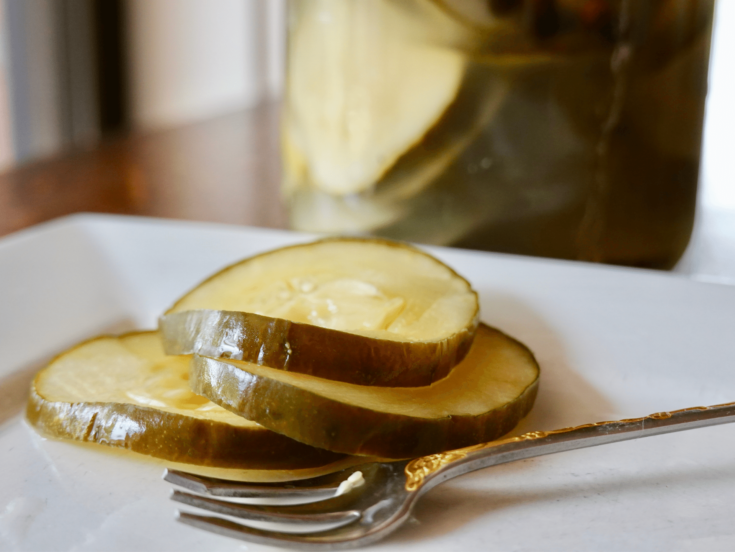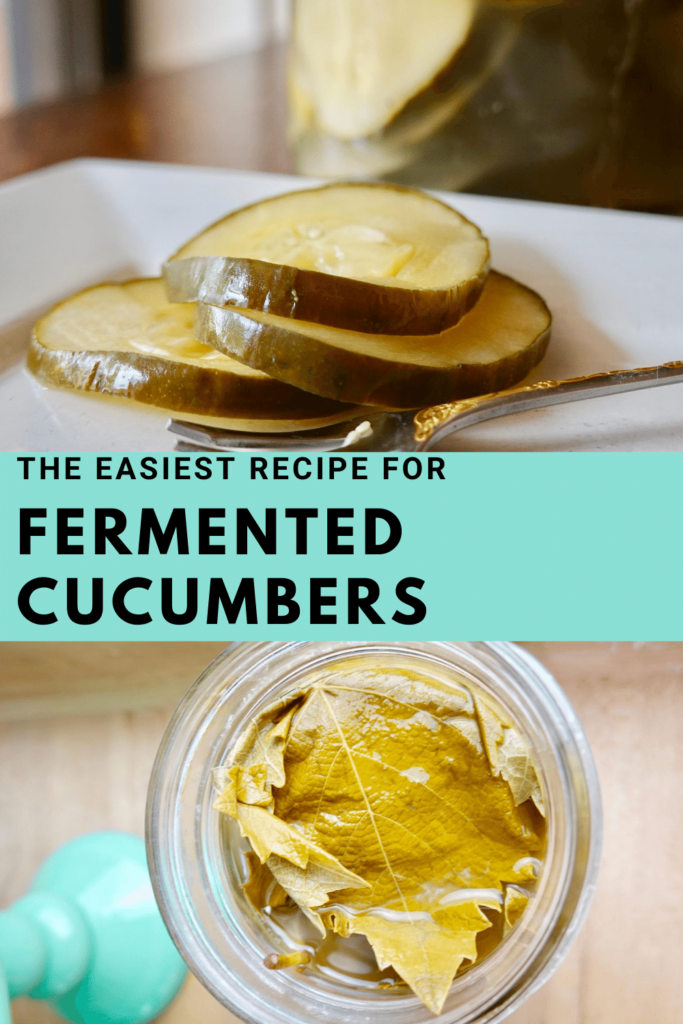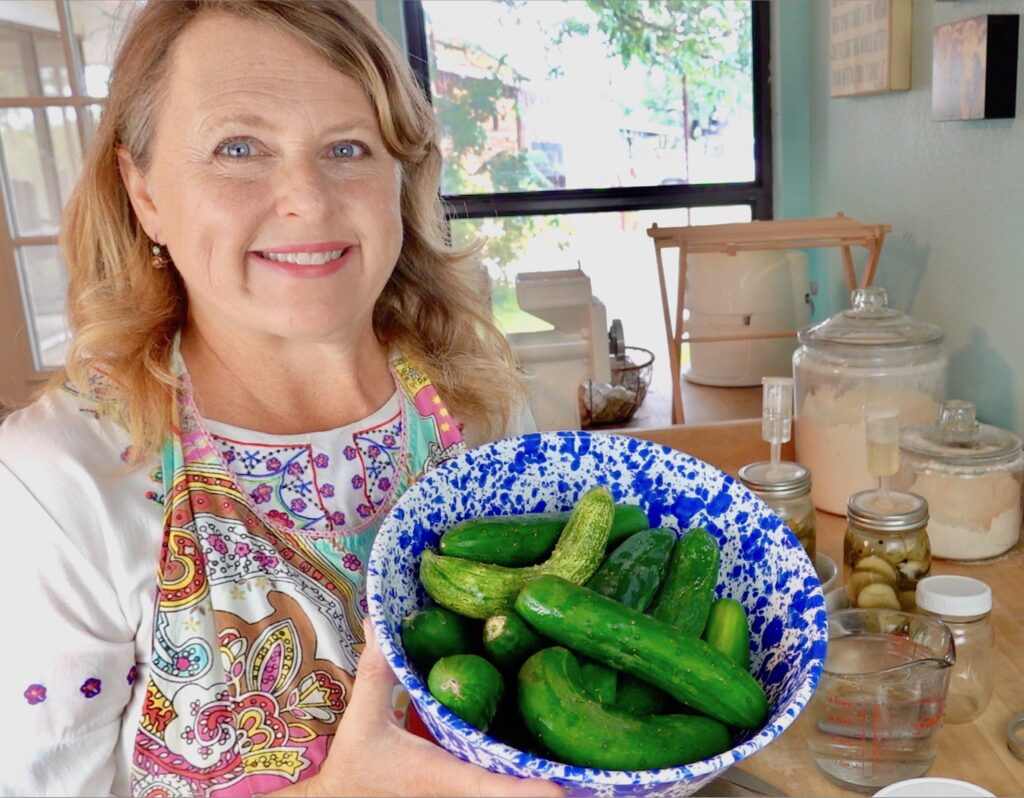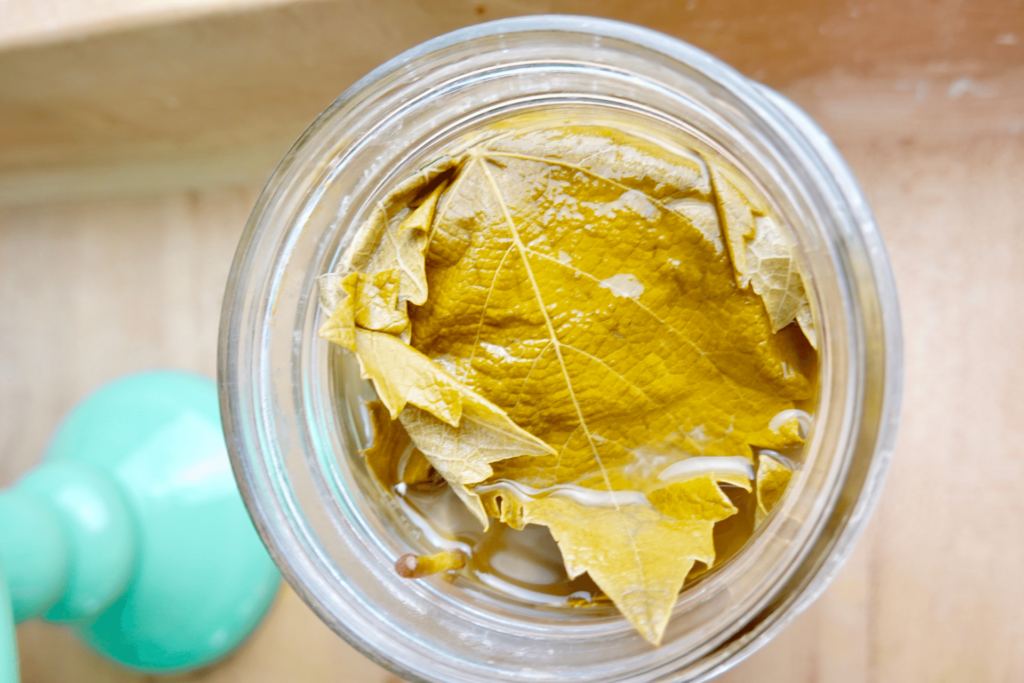Learn the easiest recipe for fermented cucumbers. This recipe only uses cucumbers and salt, so it’s simple and fast! A perfect first ferment to begin your journey into fermenting.
Fermentation is soaring with popularity and for good reason. Our ancestors used fermentation throughout history for food preservation. Not only does fermentation preserve food but adds beneficial probiotics, vitamins, and minerals. Plus fermentation enhances flavor, so that means the food is more delicious fermented than in it’s original form. Win! With so many wonderful reasons to ferment, I hope to inspire you to enter the gateway into the world of fermentation. This is the easiest recipe for fermented cucumbers, and I know you will be successful! Let’s get started!
List of what you will need for this recipe
- Fresh cucumbers – the fresher the better and organic if possible.
- Canning jars – I like the wide-mouthed quart size to ferment cucumbers.
- Canning lid or an air lock makes fermenting easy! There are so many equipment options these days!
- Some kind of glass weights to keep the cucumbers submerged. Investing in glass weights is definitely worth it because you will be fermenting for years and having glass weights will keep things simple. Check second hand stores for glass candle holders and glass beads that are used for floral arranging. I’ve found several of my glass weights at resale shops.
- Canning salt or sea salt – just make sure it is pure salt with no additives such as anti-caking.
- Additions to your ferment – Dill, garlic cloves, and peppercorns are my favorites.
- Grape Leaves, black/green tea (bagged or loose), or 2-4 bay leaves per quart jar.
- Un-chlorinated water for brine.
Let’s get the cucumbers ready!
- The bacteria that will help the cucumbers ferment are on the skin of the cucumber so wash them with cool water, not hot water.
- Slice the cucumbers in desired shape (rounds or spears)! Slicing them in rounds makes perfect pickles for hamburgers and sandwiches.
How thick should I cut the cucumber slices?
Remember cucumbers are mostly made of water and will shrink after soaking in the salt brine. Probably somewhere between 1/4-1/2 inch will be the perfect size.
Want to know my secret for crisp pickles?
- We all like our pickles crisp, right? Tannins will help keep your pickles crisp. You can use grape leaves, black tea (bags or loose), or bay leaves.
- Ferment in a cool temperature if you can. If not, ferment for a shorter time. Taste after 3 days.
- Use fresh cucumbers!
The easiest way to make brine with no waste!
For a quart of cucumbers, it almost always takes a pint of brine to cover the cucumbers. I fill a pint canning jar with un-chlorinated water, add 1 tablespoon of sea salt or canning salt, and shake until dissolved. Most of the time when you ferment you are using a small quantity of cucumbers and it’s time efficient to only make the amount of brine you need. No excess or waste!
Instructions for easy fermented cucumbers.
- Slice the cucumbers.
- Place your choice of item with tannins in the bottom of the jar.
- Stack cucumbers interspersed with flavor additions in the canning jar.
- If using grape leaves, you can fold the leaf and place on top of the cucumbers to help keep them submerged in the brine.
- Add glass weight on top of the cucumbers.
- Pour salt brine over the top of cucumbers, making sure they are below the brine to avoid mold.
- Add lid and air-lock or a canning lid and ring loose.
- Ferment for 3 days, then taste each day until your desired flavor is reached.
- This is where using an air-lock comes in handy. I ferment until the air-lock doesn’t float, then I replace the air-lock with a lid and place in cold storage.
- Make sure to put the jar in a dish because the brine will probably spill over.
I told you this was the easiest recipe for fermented cucumbers! Let’s talk about fermentation magic!
Here is a quick synopsis of how fermentation takes place:
- The bacteria needed to ferment cucumbers is on the skin of the cucumber; so fresh and organic is important. These bacteria need lots of vitamins and minerals to thrive. This kind of ferment is also known as lacto-fermentation because the bacteria are producing lactic acid.
- Lactic acid is responsible for preservation and serves as the gate-keeper to keep out bad bacteria that try to take over and ruin your ferment.
- We use salt to keep the bad bacteria in check, which gives lactic acid time to multiply into the dominate bacteria. This is so amazing!
- We need just the right amount of salt because too little salt might allow the bad bacteria to take over and too much might kill our beloved lactic acid producing bacteria.
- It is important to keep your ferments below the brine because you want an oxygen-free (anaerobic) environment. Placing a cabbage leaf, grape leaf, cut piece of bell pepper, or glass weights on the cucumbers will keep them below the brine.
- Place a lid on your ferments to keep out things like gnats. You need to leave your lid loose to allow gases produced during fermentation to escape. I use an air-lock and it works wonderfully! For more options to keep your fermenting vegetables submerged read this!
Why should you eat fermented foods?
I hope you will try making fermented cucumbers because I know you will love them and they are so good for you.
It is beneficial to add fermented foods to your meal even if served as a condiment. A small amount is good for your gut health and aids in digestion. Everyone loves pickles, so your family will love these!
After you have introduced fermented cucumbers to your family go ahead and try our “Fermented Sauerkraut Recipe”. They will love it, too!
*If your ferment smells off or when in doubt go ahead and toss it.
THE EASIEST RECIPE FOR FERMENTED CUCUMBERS

An easy recipe for probiotic-rich lacto-fermented cucumbers. You can make one jar or several at a time using this recipe. You make the brine as needed so you will avoid wasting unused brine.
Ingredients
- Fresh cucumbers-the fresher the better.
- Canning jars-I like the wide-mouthed quart size to ferment cucumbers.
- Canning lids or a canning lids with an air lock makes fermenting easy!
- Grape Leaves or a black tea bag per jar.
- Some kind of glass weights to keep the cucumbers submerged. Investing in glass weights is definitely worth it because you will be fermenting for years and having glass weights will keep things simple. Check second hand stores for glass candle holders and glass beads that are used for floral arranging. I have found several of my glass weights at resale shops.
- Canning salt or sea salt-just make sure it is pure salt with no additives such as anti-caking.
- Additions to your ferment such as-dill, garlic cloves, peppercorns are my favorites.
- Un-chlorinated water for brine.
Instructions
- Slice the cucumbers.
- Place your choice of item with tannins in the bottom of the jar.
- Stack cucumbers interspersed with additions in the canning jar.
- If using grape leaves you can fold the leaf and place on top of the cucumbers to help keep them submerged in the brine.
- Add glass weight on top of the cucumbers.
- Pour salt brine over the top of cucumbers within 1 inch of the top of the jar.
- Make sure they are below the brine to avoid mold.
- Add lid and air-lock or a canning lid and ring un-tightened.
- Make sure to put jar in a dish to catch any brine that may spill over.
Notes
- Remember cucumbers are mostly made of water and will shrink after soaking in the salt brine. Probably somewhere between 1/4-1/2 inch will be the perfect size.
- We all like our pickles crisp, right? Tannins will help keep your pickles crisp. You can use grape leaves, black/green tea bags or loose, or bay leaves.
- For a quart of cucumbers It almost always takes a pint of brine to cover the cucumbers. I fill a pint canning jar with un-chlorinated water, add 1 tablespoon of canning salt, shake until dissolved, now the brine is ready to pour over cucumbers.










